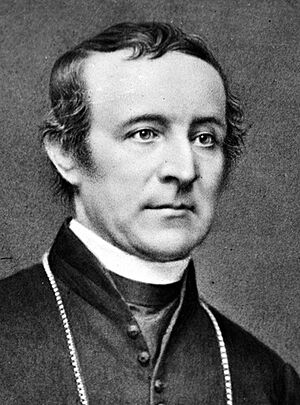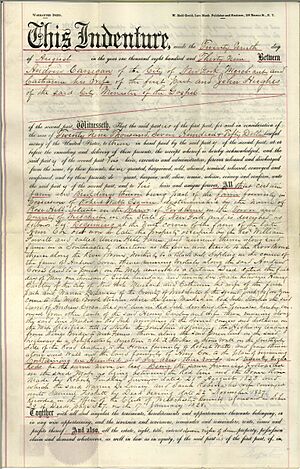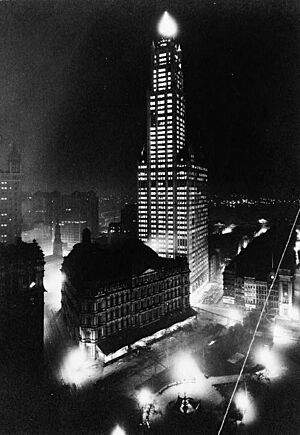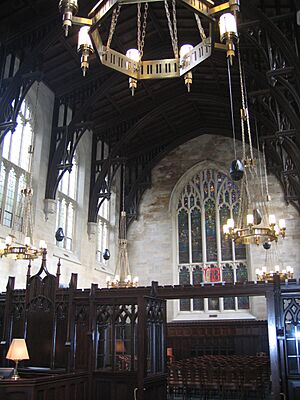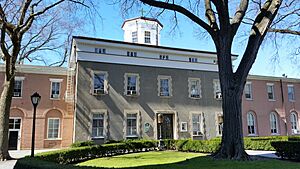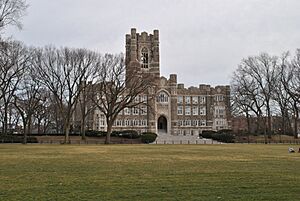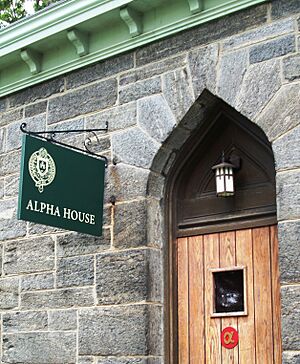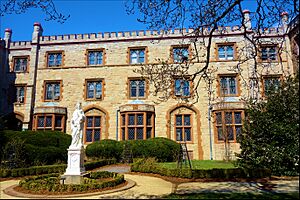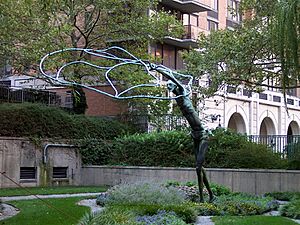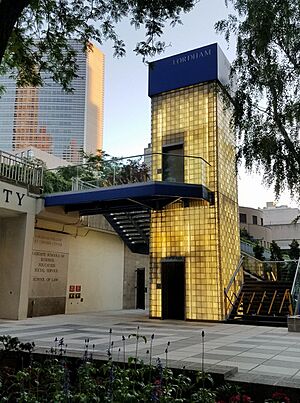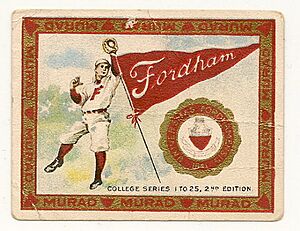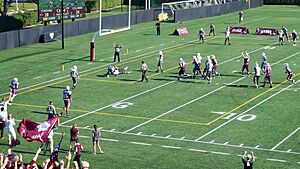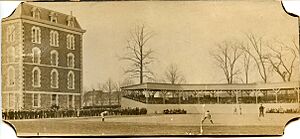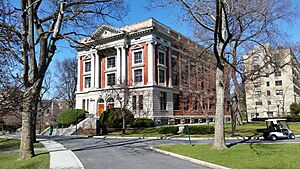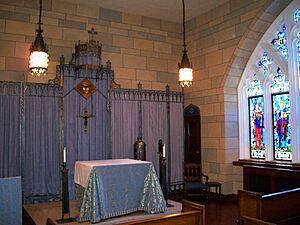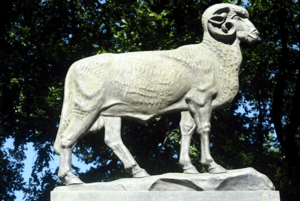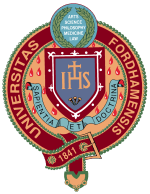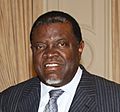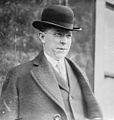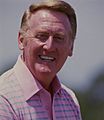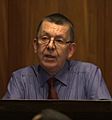Fordham University facts for kids
 |
|
| Latin: Universitas Fordhamensis | |
|
Former names
|
St. John's College (1841–1907) Marymount College (absorbed 2002) |
|---|---|
| Motto | Sapientia et Doctrina (Latin) |
|
Motto in English
|
Wisdom and Learning |
| Type | Private research university |
| Established | June 24, 1841 |
| Founder | John Hughes |
|
Religious affiliation
|
Catholic (Jesuit) |
|
Academic affiliations
|
|
| Endowment | $972 million (2022) |
| President | Tania Tetlow |
| Provost | Dennis C. Jacobs |
|
Academic staff
|
747 |
| Students | 16,986 |
| Undergraduates | 9,904 |
| Postgraduates | 7,082 |
| Location |
,
U.S.
40°51′43″N 73°53′10″W / 40.86194°N 73.88611°W |
| Campus | Main:
London Centre (Clerkenwell): 0.39 acres (0.2 ha) |
| Colors | Maroon & White |
| Nickname | Rams |
|
Sporting affiliations
|
|
| Mascot | The Ram |
 |
|
Fordham University is a private university in New York City. It was founded in 1841. The university is named after the Fordham neighborhood in the Bronx. Its first campus is located there. Fordham is the oldest Catholic and Jesuit university in the northeastern United States. It is also the third-oldest university in New York State.
A bishop named John Hughes started Fordham as St. John's College. Later, the Jesuits took over the school. Today, Fordham is an independent school. It is still connected to the Jesuits and their teaching ideas.
Fordham has about 15,300 students from over 65 countries. It has ten colleges, with four for undergraduate students and six for graduate students. These are spread across three main campuses in southern New York State. These campuses are Rose Hill in the Bronx, Lincoln Center in Manhattan, and Westchester in West Harrison. Fordham also has a study abroad center in London. It has offices in Spain and South Africa too. Students can choose from over 60 different subjects to study.
The university's sports teams are called the Rams. Their football team won the Sugar Bowl once. It also had two players who became famous in the Pro Football Hall of Fame. The Rams played in the first televised college football game in 1939. They also played in the first televised college basketball game in 1940. Fordham's baseball team played the first college baseball game using modern rules in 1859. Many of its players went on to play in Major League Baseball. The team holds the record for the most wins in NCAA Division I baseball history.
Many famous people have studied or taught at Fordham. These include former President Donald Trump, U.S. Senators, and U.S. Representatives. Four cardinals of the Catholic Church also attended. Other alumni include U.S. governors, ambassadors, and billionaires. Two directors of the CIA, actors who won Academy Awards and Emmys, and even royalty have been part of the Fordham community.
Contents
Fordham University's History
Fordham University has a rich history. It started as a small college and grew into a major university.
How Fordham Began: 1841–1900
Fordham began as St. John's College in 1841. It was founded by John Hughes, a bishop in New York. This makes it the third-oldest university in New York State. It was also the first Catholic college in the northeastern United States. In 1839, Bishop Hughes bought a large farm called Rose Hill Manor. He wanted to build a seminary there. A seminary is a school for training priests.
St. John's College opened on June 24, 1841. It started with only six students. The first president was John McCloskey. He later became the first American Cardinal. In 1845, Bishop Hughes asked Jesuit priests from Kentucky to help run St. John's.
The college received its official charter from New York State in 1846. Soon after, Bishop Hughes sold St. John's College to the Jesuits for $40,000. In 1847, Fordham opened its first school in Manhattan. The famous American poet Edgar Allan Poe lived near Fordham around this time. He was friends with the Jesuits. Some people believe the college's church bells inspired his poem The Bells.
The college taught subjects like Latin, Greek, history, and math. Students could earn a Bachelor's degree. They could also study business. During the American Civil War, many Fordham alumni fought. Some fought for the Union, and others for the Confederacy. Three Jesuits from the college served as army chaplains.
Fordham's baseball team started in 1859. It played a big role in bringing baseball to Cuba and Latin America. On November 3, 1859, Fordham played the first college baseball game with nine players on each team. They won 33–11. Steve Bellán, the first Cuban to play Major League Baseball, learned the game at Fordham.
In 1885, a military training program began at Fordham. This program helped create the modern ROTC unit at the university. By 1897, students started wearing special robes for graduation ceremonies.
Growing Up: 1901–1950
On March 7, 1907, St. John's College officially became Fordham University. The name "Fordham" comes from the village where the main campus is. This village was named for a shallow crossing ("ford") over the Bronx River.
In 1908, Fordham University Press was started. This is the university's publishing house. In 1912, the College of Pharmacy opened. It offered a three-year program. In September 1912, the famous Swiss psychiatrist Carl Jung gave lectures at Fordham. These lectures were important because they marked his break from Sigmund Freud's ideas.
In 1913, Fordham opened new colleges in the Woolworth Building in Manhattan. Later, some parts of the university moved to 302 Broadway. This started Fordham's continuous presence in Manhattan. Today, all of Fordham's Manhattan operations are at the Lincoln Center campus.
The university closed its medical school in 1919. This was due to a lack of money after First World War. The Gabelli School of Business started in 1920. In 1944, the School of Professional and Continuing Studies opened. Many returning soldiers used their GI Bill benefits to study there.
Fordham's football program became very famous in the early 1900s. They played in big stadiums like the Polo Grounds and Yankee Stadium. The team was known for its strong offensive line, called the "Seven Blocks of Granite". One of these players was Vince Lombardi, who became a legendary coach. On September 30, 1939, Fordham played in the world's first televised football game.
Two U.S. presidents visited Fordham in the 1940s. President Franklin D. Roosevelt visited in 1940. President Harry S. Truman visited in 1946 for the university's 100th anniversary. Truman gave a speech about education and peace. During his visit, Truman rang the Fordham "victory bell" for the first time. This bell was from a Japanese aircraft carrier. It now rings after all Fordham sports victories.
Becoming Independent: 1951–2000
In 1958, Senator John F. Kennedy received an honorary degree from Fordham. He gave a speech at a law alumni event.
In 1961, the Lincoln Center campus opened. This campus brought higher education to a cultural area of Manhattan. The School of Law was the first to move there. Later, other academic programs joined. In 1961, then-Attorney General Robert F. Kennedy also visited Fordham. He spoke at the dedication of the new Law School building.

Fordham started accepting women earlier in the century. The Law School began accepting female students in 1918. Women also studied in the Graduate School of Social Service and the Undergraduate School of Education. In 1964, the all-female Thomas More College opened at the Rose Hill campus.
In the late 1960s, Fordham became a place for student activism. Students protested against military programs on campus. In 1969, a student sit-in forced President Richard Nixon to cancel a speech at Fordham. The university's African and African American Studies Department was founded during this time.
In 1969, the university's board of trustees changed. Most members were no longer priests. This made Fordham an independent institution. However, it still keeps its "Jesuit, Catholic university" identity. The College of Pharmacy closed in 1972. Fordham College at Rose Hill became coeducational in 1974. This happened when it merged with Thomas More College.
Fordham Preparatory School is a high school that was once part of the university. It became independent in 1972. It moved to its own buildings on the Rose Hill campus.
Recent Years: 2001–Present
Marymount College, a women's college, joined Fordham in 2002. Marymount had faced financial problems. Fordham kept the campus open for graduate programs for a while.
In 2005, Fordham decided to close the Marymount College campus. The university sold the campus in 2008 for $27 million. The remaining programs moved to a new location in Harrison, New York.
In 2014, Fordham finished a big fundraising campaign. They raised over $540 million. The university also renovated and expanded its Lincoln Center campus. A new Law School building and a new student dormitory, McKeon Hall, opened.
What Students Study at Fordham
Fordham University has ten schools. Four are for undergraduate students, and six are for graduate students.
| School | Started |
|---|---|
| Fordham College (Rose Hill) |
|
| School of Law |
|
| Fordham College (Lincoln Center) |
|
| Graduate School of Arts and Sciences |
|
| Graduate School of Education |
|
| Graduate School of Social Service |
|
| Gabelli School of Business |
|
| School of Professional and Continuing Studies |
|
| Graduate School of Religion and Religious Education |
|
Fordham's teaching style is based on its Jesuit roots. It follows principles like cura personalis, which means respecting each student. magis encourages students to aim for excellence. homines pro aliis inspires students to serve others.
Fordham offers over 130 study abroad programs. These programs can last from six weeks to a full year. They focus on culture, language, internships, or service. Fordham has its own programs in London, Spain, and South Africa. It also partners with other universities. Since 2003, Fordham has had 168 Fulbright scholars. These are students who receive special grants to study abroad.
Getting into Fordham
Fordham is considered a "more selective" university. This means it's competitive to get in.
| 2013 | 2014 | 2015 | 2016 | |
|---|---|---|---|---|
| Applicants | 36,189 | 40,912 | 42,811 | 44,768 |
| Admits | 17,055 | 19,685 | 20,366 | 20,214 |
| Admit rate | 47% | 48% | 47% | 45% |
| Enrolled | 1,967 | 2,258 | 2,211 | 2,160 |
In 2016, Fordham accepted about 43% of all applicants. For the class of 2019, Fordham accepted 20,366 out of 42,811 applicants. This was about 47.6%. The average high school GPA for new students was 3.64.
What Undergraduates Study
All undergraduate students at Fordham must complete the Core curriculum. This includes 17 courses in nine subjects. These subjects are English, math, social science, philosophy, history, fine arts, religious studies, science, and languages. This Core curriculum is based on Jesuit teaching principles. It focuses on a broad education in the liberal arts.
Students usually finish most Core requirements by their second year. After that, they choose from about 50 major subjects. Students can even create their own major by combining different subjects.
Fordham also offers special programs. These include programs for students interested in medicine, law, or engineering. There's also a program for dance students with the Alvin Ailey American Dance Theater.
Graduate Programs
Fordham offers Master's and Doctoral degrees. These are through its various graduate schools. These include the Graduate School of Arts and Sciences, the School of Law, and the Gabelli School of Business. Many of Fordham's graduate programs are ranked among the top 100 in the nation.
Fordham's medical school closed in 1919. However, it still offers medical education through a partnership. It works with the Albert Einstein College of Medicine. This allows Fordham science students to take classes and do research there.
Research at Fordham

Fordham is known for its research. The university library system has over 2.5 million books. It also has many periodicals and audiovisual materials. Students and faculty can also access millions more books through other libraries in New York City.
Fordham has special collections. The Fordham Museum of Greek, Etruscan, and Roman Art is at Rose Hill. It has over 200 ancient artifacts. The university also has a large art collection. It also has rare books and manuscripts.
Other research places include the Louis Calder Center. This is a biological field station with 114 acres of forest. Fordham also works with other research institutions. These include the New York Botanical Garden and the Bronx Zoo.
Fordham University Press publishes research in the humanities and social sciences. The university also holds an Undergraduate Research Symposium each year. This is where students can present their research.
Honors and Military Programs
Fordham offers honors programs for students who excel academically. These programs have special classes and research projects. Students who graduate from an honors program get a special mention on their diploma.
Fordham also has chapters of many honor societies. These are groups that recognize students for their achievements in different subjects.
The Office of Prestigious Fellowships helps students apply for special scholarships. Fordham is known for producing many U.S. Fulbright students.
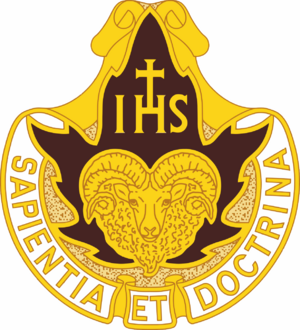
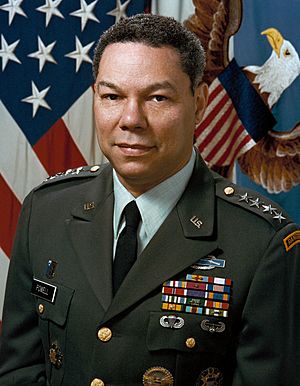
Fordham has a Military Science program. It is open to all students. This program includes training in the Army Reserve Officer Training Corps (ROTC). Students can also join the Air Force ROTC or Navy ROTC programs. Many famous military leaders have come from Fordham's program. These include former Secretary of State Colin Powell.
Fordham also helps veterans. Its Veterans Initiative gives full scholarships to veterans. This is why Fordham was named one of the best colleges for veterans.
Fordham's Campuses
Fordham has three main campuses in and around New York City.
These are Rose Hill in the Bronx, Lincoln Center in Manhattan, and Westchester in West Harrison. Fordham also has a biological field station called the Louis Calder Center. It is located north of New York City.
Outside the U.S., Fordham has a campus in London. It also has offices in Spain and South Africa for study abroad programs.
Rose Hill Campus
The Rose Hill campus was established in 1841. It is home to Fordham College at Rose Hill and the Gabelli School of Business. This campus is 85 acres large. It is one of the biggest private green spaces in New York City. It is next to the Bronx Zoo and the New York Botanical Garden. Fordham students can visit the garden for free.
Rose Hill has many old buildings. The Fordham University Church was built in 1845. It has stained glass windows given by a French king. There is also a cemetery on campus for early Jesuits and students.
There are eleven dorms at Rose Hill. Queen's Court helps new students settle into university life. The campus also has two homes for Jesuits.
Rose Hill is easy to reach by public transport. The Fordham train station is nearby. Buses also stop near the campus. Fordham also has a shuttle service, called the "Ram Van," that connects its campuses.
Lincoln Center Campus
The Lincoln Center campus opened in 1961. It is home to Fordham College at Lincoln Center, the School of Law, and other graduate schools. This 8-acre campus is in the middle of Manhattan. It is close to Central Park.
Lincoln Center has two grassy areas. One is called "St. Peter's Garden." It has a memorial for Fordham students and alumni who died in the September 11, 2001, attacks. The campus is served by public buses and subway trains. The Ram Van shuttle also connects it to other campuses.
The campus has several buildings, including the Leon Lowenstein Building and McMahon Hall. In 2014, a new dorm, McKeon Hall, opened. A new Law School building also opened that year. Fordham plans to continue improving the Lincoln Center campus in the future.
Westchester Campus
The Westchester campus is home to parts of the School of Professional and Continuing Studies. It also houses graduate schools for business, education, and social service. The campus has a three-story building on 32 acres of land. It has classrooms, offices, and meeting areas. Fordham renovated the building to make it more environmentally friendly.
The campus is about 4 miles from the White Plains train station. It is also served by the local bus system.
London Centre
In 2018, Fordham opened its own study abroad campus in London. It is called the London Centre. It is located in the Clerkenwell area of London. The London Centre offers programs in business, theater, and liberal arts. Students from Fordham and other universities can study there.
Sports at Fordham

Fordham has 21 men's and women's varsity sports teams. It also has many club and intramural sports. The university's colors are maroon and white. Its mascot is the ram. Most teams compete in NCAA Division I. They are part of the Atlantic 10 Conference. The football team plays in NCAA Division I FCS. It is part of the Patriot League.
The Rams football team has won two Patriot League championships. It is famous for its "Seven Blocks of Granite" offensive lines from the 1920s and 1930s. One player from this group was Vince Lombardi, a legendary football coach. The Los Angeles Rams NFL team was named in honor of Fordham's football history.
The Fordham men's basketball program has been in the NCAA Tournament four times. It has also been in the National Invitational Tournament 16 times. The team's best season was in 1971. They had a 26–3 record and were ranked No. 9 nationally. Fordham basketball plays in the Rose Hill Gymnasium. This is the oldest college basketball arena still used by a Division I team.
The Rams baseball program is one of the oldest in the country. It was the first college team to play baseball with modern rules. Many of its players have gone on to play in Major League Baseball. This includes National Baseball Hall of Fame member Frankie Frisch. The team holds the record for the most wins in NCAA Division I baseball history.
Fordham has eight women's teams. The women's basketball team won the Atlantic 10 championship in 2014. They then went to the first round of the NCAA Women's Division I Basketball Championship.
Other sports include track and field, sailing, crew, and golf.
Student Life at Fordham
Student Groups and Activities
Fordham has over 130 student clubs and organizations at Rose Hill. There are 50 at Lincoln Center.
The university has many theater groups. These include the Mimes and Mummers, which started in 1855. It is one of the oldest student-run theater groups in the U.S. They put on musicals, dramas, and comedies each year. Fordham also has several choirs and a cappella groups.
In 1905, Fordham became the first place on the East Coast to have a theater in the round. This was the Penthouse Theatre in Collins Hall.
Rodrigue's Coffee House, or "Rod's," is a student-run coffee house and event space. It is in Alumni House. Many famous artists have performed there.
Campus Media
Fordham has several student publications. The Fordham Ram is the official newspaper for the university. The Observer is the newspaper for the Lincoln Center campus. The Fordham Political Review covers politics and international affairs.
WFUV is Fordham's radio station. It broadcasts on 90.7 FM. It reaches about 350,000 listeners each week in New York City. It is part of National Public Radio. In 2017, The Princeton Review ranked WFUV the second best college radio station in the U.S.
Campus Ministry and Service
Campus Ministry at Fordham helps students grow spiritually. It offers programs for over 15 different faiths. One popular program is retreats. These are held at the university's McGrath House of Prayer.
The university has a church and many chapels. The Fordham University Church is at Rose Hill. The Blue Chapel is in Keating Hall.
Global Outreach (GO!) is a program where students learn about social issues. They live simply and work with partner organizations. GO! has projects across the United States and in other countries.
The Dorothy Day Center for Service and Justice organizes community service projects. It helps students volunteer in areas like poverty, hunger, and education. In 2011, Fordham students did about one million hours of service. This ranked Fordham sixth nationally for community outreach.
Sustainability Efforts
Fordham is working to be more sustainable. It plans to reduce its greenhouse gas emissions by 30% by 2017. The university uses water-saving fixtures and recycled materials in its buildings. It also recycles most of its construction waste. Fordham aims for LEED Silver certification for new buildings.
The university also uses green cleaning products. It has a recycling program and composts with the New York Botanical Garden.
Fordham's Rose Hill campus has one of the largest collections of old American elms in the country. Some are over 270 years old.
Traditions and Symbols
Fordham University has many traditions and symbols.
University Traditions
- The President's Ball happens every autumn. It is a formal event held before the Homecoming football game.
- The Winter Ball is a semi-formal event. It is held in New York City venues like the Rainbow Room.
- The "Under the Tent" Dance is held before final exams. It takes place on Martyrs' Lawn at Rose Hill. It is part of the Spring Weekend Festival.
- The Festival of Lessons and Carols is a Christmas concert. The university choir performs it each year.
- A "midnight breakfast" marks the start of final exams. Fordham staff cook breakfast for students to help them prepare for studying.
- The Liberty Cup was a trophy for the football game between Fordham and Columbia universities. This tradition ended in 2016.
- The Rams-Crusader Trophy is awarded in football. It honors a coach who worked at both Fordham and Holy Cross.
- Fordham College at Rose Hill hosts an Encaenia each May. This ceremony celebrates graduating students.
Fordham Symbols
- Fordham's official color is maroon. It used to be magenta, but they changed it in 1874. Maroon was chosen because it was not widely used by other schools.
- The Victory Bell was given to Fordham by the U.S. Navy. It was originally the bell from a Japanese aircraft carrier. President Harry S. Truman first rang it in 1946. It now rings after all Fordham sports victories and at graduation.
- The Great Seal of Fordham University shows its Jesuit connection. It has the IHS monogram, which is a symbol for Jesus. It also has three nails from the Crucifixion. The seal includes a laurel crown and symbols of the university's early subjects. The university's motto, SAPENTIA ET DOCTRINA (Wisdom and Learning), is also on the seal. The seal is surrounded by a belt with the university's Latin name and founding date (1841).

- The mace of Fordham is carried at graduation ceremonies. It has a crown, a cross, and the university's seal. It also has names of past presidents.
- The Terrace of the Presidents is a tradition started by a former Fordham president. The names of heads of state who visit the university are engraved on the steps leading to Keating Hall.
- Fordham's official song is "Alma Mater Fordham." Its fight song is "Fordham Ram." In 2013, the lyrics to "Fordham Ram" were changed to include female students.
Famous Fordham Alumni and Faculty
Fordham has over 183,500 alumni around the world. Many have become leaders in various fields.
Geraldine Ferraro was the first woman to run for Vice President of the United States from a major political party. She attended Fordham. Many members of the United States Congress also went to Fordham. Andrew Cuomo, a former Governor of New York, is an alumnus. Donald Trump, the 45th President of the United States, attended Fordham for two years.
Fordham alumni include military heroes. These include Colin Powell, a former Secretary of State. He was also a four-star general.
Many business leaders studied at Fordham. These include Anne M. Mulcahy, former CEO of Xerox. Mario Gabelli and Lorenzo Mendoza are billionaires who attended Fordham.
In media, Fordham alumni include Charles Osgood, a famous journalist. Vin Scully, a legendary sportscaster, also went to Fordham.
In arts and entertainment, Fordham has produced many stars. These include Denzel Washington and Alan Alda, who both won Academy Awards and Emmys. Singer-songwriter Lana Del Rey and best-selling novelist Mary Higgins Clark are also alumni.
In sports, Baseball Hall of Fame member Frankie Frisch attended Fordham. So did Vince Lombardi, the famous football coach.
- Notable Fordham alumni:
-
Alan Alda, Emmy and Golden Globe-winning actor
-
William J. Casey, former Director of the Central Intelligence Agency
-
Mary Higgins Clark, novelist
-
Patricia Clarkson, Academy Award-nominated actress
-
Don DeLillo, Pulitzer Prize-nominated novelist
-
Lana Del Rey, singer-songwriter
-
John La Farge, visual artist
-
Geraldine Ferraro, U.S. Representative and vice-presidential candidate
-
Martin H. Glynn, 40th Governor of New York
-
Michael Kay, sports broadcaster for the New York Yankees
-
Vin Scully, sportscaster
-
Robert Gould Shaw, Civil War commander
-
Donald Trump, 45th president of the United States
-
Denzel Washington, Academy Award-winning actor
Notable Current and Former Faculty
-
Victor Francis Hess, Nobel Prize winner
-
Olivia Hooker, first African-American woman in the U.S. Coast Guard
-
Carl Jung, founder of analytical psychology
Images for kids
-
Fordham's Rose Hill campus has many old American elms
See also
 In Spanish: Universidad de Fordham para niños
In Spanish: Universidad de Fordham para niños


